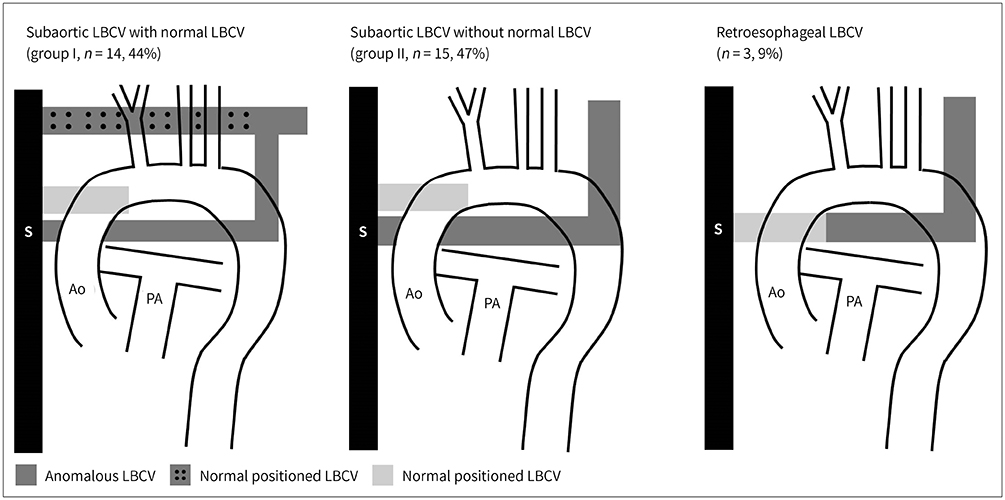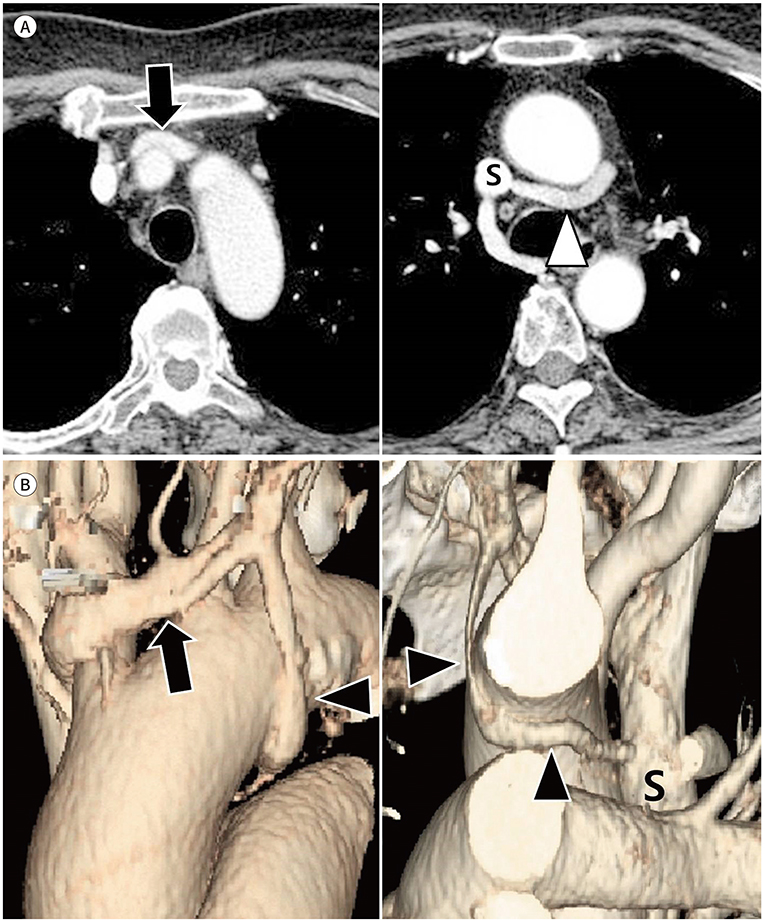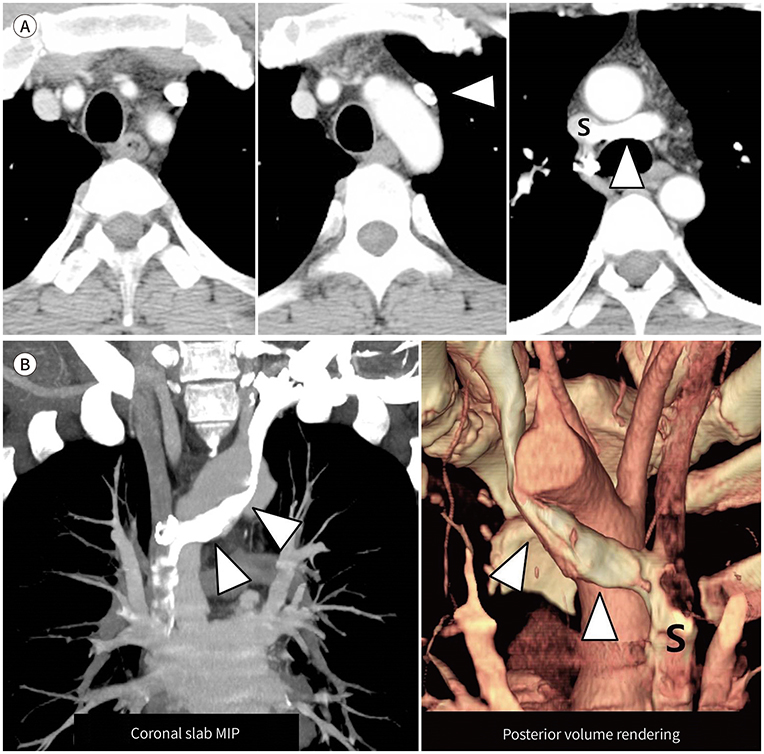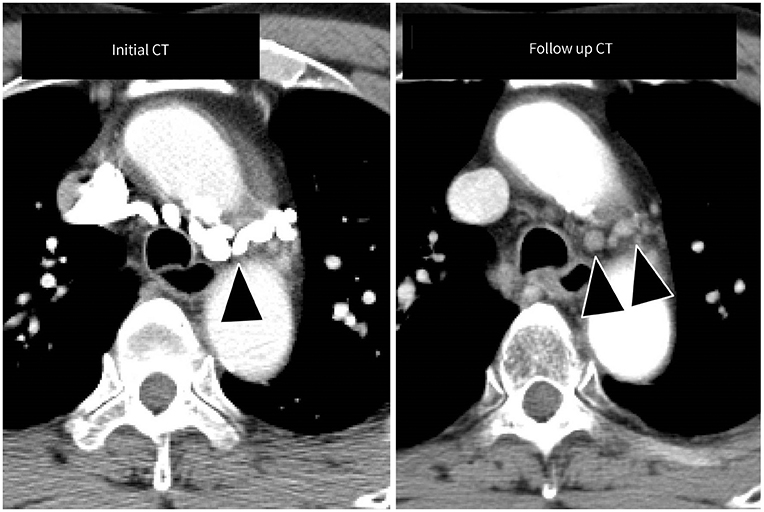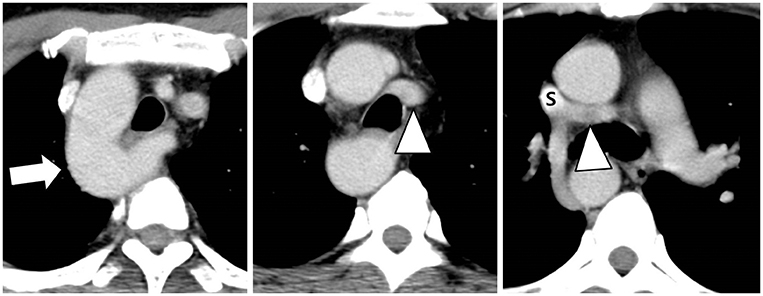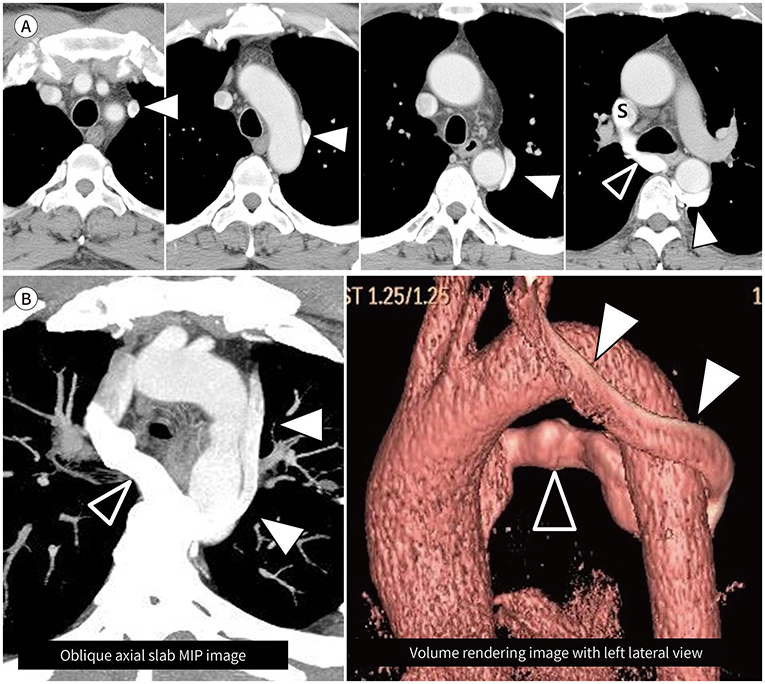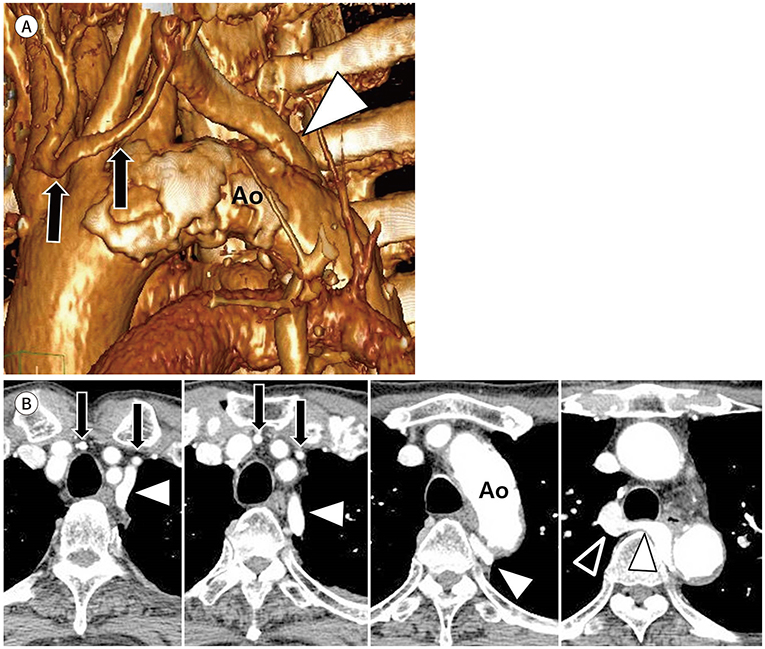J Korean Soc Radiol.
2019 Sep;80(5):942-952. 10.3348/jksr.2019.80.5.942.
The Anomalous Left Brachiocephalic Vein in Adults
- Affiliations
-
- 1Department of Radiology, Sooncheonhyang University Cheonan Hospital, Cheonan, Korea. ytokim@schmc.ac.kr
- KMID: 2459019
- DOI: http://doi.org/10.3348/jksr.2019.80.5.942
Abstract
- PURPOSE
To classify anomalous left brachiocephalic vein (LBCV) in adult without cardiac anomaly, and evaluate CT findings of anomalous LBCV.
MATERIALS AND METHODS
This study included 32 patients who were diagnosed anomalous LBCV using MDCT between March 2005 and August 2016. Subaortic LBCV divided into group I (with normal LBCV) and group II (without normal LBCV). We evaluated age, sex, diameters and diameter ratios of superior vena cava (SVC) and subaortic LBCV, the entering sites to SVC of subaortic LBCV and the azygos vein, and vascular tortuosity of subaortic LBCV.
RESULTS
There were included 29 subaortic LBCV and 3 retroesophageal LBCV. There were not statistically significant in age, sex, diameter of SVC between subaortic groups (p > 0.05). The diameters of subaortic LBCV were thinner in group I. Diameter ratios of subaortic LBCV were lower in group I. The entering site of subaortic LBCV was higher than azygos vein in group I (64%) and same as azygos vein in group II (67%). Vascular tortuosity of subaortic LBCV was in 7 cases of group I.
CONCLUSION
It is important for radiologists to be familiar with CT findings of anomalous LBCV, since the radiologists give information of uncommon or rare anomalous LBCV to clinician.
Figure
Reference
-
1. Kershner L. Morphologie der vena cava inferior. Anat Anz. 1888; 3:808–823.2. Curtil A, Tronc F, Champsaur G, Bozio A, Sassolas F, Carret JP, et al. The left retro-aortic brachiocephalic vein: morphologic data and diagnostic ultrasound in 27 cases. Surg Radiol Anat. 1999; 21:251–254.
Article3. Sinkovskaya E, Abuhamad A, Horton S, Chaoui R, Karl K. Fetal left brachiocephalic vein in normal and abnormal conditions. Ultrasound Obstet Gynecol. 2012; 40:542–548.
Article4. Chen SJ, Liu KL, Chen HY, Chiu IS, Lee WJ, Wu MH, et al. Anomalous brachiocephalic vein: CT, embryology, and clinical implications. AJR Am J Roentgenol. 2005; 184:1235–1240.
Article5. Takada Y, Narimatsu A, Kohno A, Kawai C, Hara H, Harasawa A, et al. Anomalous left brachiocephalic vein: CT findings. J Comput Assist Tomogr. 1992; 16:893–896.6. Chern MS, Ko JS, Tsai A, Wu MH, Teng MM, Chang CY. Aberrant left brachiocephalic vein: CT imaging findings and embryologic correlation. Eur Radiol. 1999; 9:1835–1839.
Article7. Ming Z, Aimin S, Rui H. Evaluation of the anomalous retroesophageal left brachiocephalic vein in Chinese children using multidetector CT. Pediatr Radiol. 2009; 39:343–347.
Article8. Yigit AE, Haliloglu M, Karcaaltincaba M, Ariyurek MO. Retrotracheal aberrant left brachiocephalic vein: CT findings. Pediatr Radiol. 2008; 38:322–324.
Article9. Gerlis LM, Ho SY. Anomalous subaortic position of the brachiocephalic (innominate) vein: a review of published reports and report of three new cases. Br Heart J. 1989; 61:540–545.
Article10. Choi JY, Jung MJ, Kim YH, Noh CI, Yun YS. Anomalous subaortic position of the brachiocephalic vein (innominate vein): an echocardiographic study. Br Heart J. 1990; 64:385–387.
Article11. Mill MR, Wilcox BR, Detterbeck FC, Anderson RH. Anomalous course of the left brachiocephalic vein. Ann Thorac Surg. 1993; 55:600–602.
Article12. Adachi B. Anatomie der Japaner: II, das Venensystem der Japaner. Kyoto: Kyoto University Press;1933. p. 83–87.13. Smallhorn JF, Zielinsky P, Freedom RM, Rowe RD. Abnormal position of the brachiocephalic vein. Am J Cardiol. 1985; 55:234–236.
Article
- Full Text Links
- Actions
-
Cited
- CITED
-
- Close
- Share
- Similar articles
-
- Double Left Brachiocephalic Veins with Persistent Left Superior Vena Cava: A Case Report
- Circumaortic Left Brachiocephalic Vein: CT Findings
- An Unusual Cause of Left Brachiocephalic Vein Occlusion: Extrinsic Compression by the Aortic Arch in a Hemodialysis Patient
- Anomalous Pulmonary Venous Return Accompanied by Normal Superior Pulmonary Veins in the Left Upper Lobe: A Case Report
- Subaortic Left Brachiocephalic Vein

